Chapter 1 Cell Pathology
CELL INJURY
3 What could cause cell injury?
 Action of toxins and other adverse influences that could inhibit the vital cell functions (e.g., oxidative phosphorylation or protein synthesis)
Action of toxins and other adverse influences that could inhibit the vital cell functions (e.g., oxidative phosphorylation or protein synthesis)10 Where does water accumulate during hydropic change?
Water accumulates in the hyaloplasm but also in the invaginations of the plasma membrane (hypoxic vacuoles), mitochondria, and the cisterns of rough endoplasmic reticulum (RER), causing their malfunction. Swollen mitochondria produce less energy, and the detachment of ribosomes from membranes of dilated RER results in reduced protein synthesis (Fig. 1-1).
11 What is the role of calcium in acute cell injury?
 Phospholipases: These enzymes remove phospholipids from the plasma or mitochondrial membranes, further impairing their function.
Phospholipases: These enzymes remove phospholipids from the plasma or mitochondrial membranes, further impairing their function. Endonucleases: These enzymes act on the RNA and DNA.
Endonucleases: These enzymes act on the RNA and DNA.All of these changes are initially reversible, but if prolonged or intensified they may lead to irreversible cell injury (Fig. 1-2).
16 Which mitochondrial changes are irreversible?
Swelling of mitochondria represents a reversible change. Irreversible changes include the following:
18 Which nuclear changes are signs of cell death?
Dead cells show typical nuclear changes (Fig. 1-4):
 Pyknosis: This term is derived from the Greek word pyknos meaning “dense,” and it denotes condensation of chromatin.
Pyknosis: This term is derived from the Greek word pyknos meaning “dense,” and it denotes condensation of chromatin. Karyorrhexis: This term is derived from the Greek word rhexis meaning “tearing apart” and denotes fragmentation of nuclear material. Colloquially, it is described as formation of “nuclear dust.”
Karyorrhexis: This term is derived from the Greek word rhexis meaning “tearing apart” and denotes fragmentation of nuclear material. Colloquially, it is described as formation of “nuclear dust.”Stay updated, free articles. Join our Telegram channel

Full access? Get Clinical Tree























